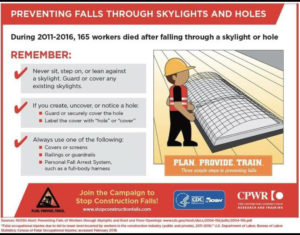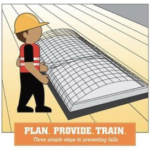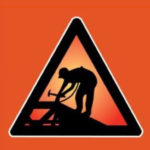Holding a Stand Down Plan
There is no one way to hold a stand‐down, so please feel free to get creative and do what works for your employees and job sites. For even more resources and ideas,visits topconstructionfalls.com.
MONDAY – MAKE THE CASE FOR FOCUSING ON FALLS
Despite the risk of a fall being so high, and many worker shaving seen a severe fall first hand, some may still feel that they are not at risk for falls, or that “it can’t happen to them.” Using real life stories and statistics can help bring the Stand Down home. Once workers have accepted that the risk is real for them,they will be interested in participating in training and the other activities below. Ways to make the case for focusing on falls include:
- Use CPWR‐NIOSH Infographics to share statistics on fall risk. Four new infographics are available this year, including: falls from equipment, falls through skylights or holes, small businesses, fall protection access.
- Use stories of your own experiences or those of others on your jobsite who experienced or witnessed a fall resulting in injury or death.
- Check out CPWR’s Fatality Maps – interactive maps that pin point fall ‐ related fatalities across the US and share news reports and information about those killed.
- Use NIOSH & State Fatality Assessment and Control Evaluation (FACE) Reports and Products–Investigations conducted through the FACE program allow the identification of factors that contribute to these fatal injuries. This information is used to develop comprehensive recommendations for preventing similar deaths. A list of fall‐related FACE reports can be found on stopconstructionfalls.com.


TUESDAY – CONDUCT A TOOLBOX TALK
Toolbox Talks are short and easy on‐site trainings that only last approximately 5‐15 minutes each. Workers attending the talk should be encouraged to ask questions and discuss the topic. This increases the likelihood they will remember the information. Visit http://stopconstructionfalls.com/toolbox‐talks/ for ready‐to‐use Toolbox Talks from CPWR. Topics include:
- Aerial Lifts
- Preventing Falls From Roofs
- Preventing Falls From Scaffolding
- Falls: Extension Ladders
- Falls: Step Ladders
- Equipment: Getting On and Off
- Falls: General Protection and Awareness
- Falls From Moving Machinery
- Falls Through Holes and Openings
WEDNESDAY – REINFORCE THE MESSAGE WITH POSTERS, STICKERS, & HANDOUTS
Training is important, but in order to make sure the message hits home and workers retain the information, it is useful to reinforce the Stand‐Down in a variety of ways :
- Hang posters around your jobsite(s). OSHA has a 2018 poster available for download in English and Spanish , but many contractors choose to create their own posters with company branding instead. You may also want to consider a poster making activity hold a contest for the best drawn poster, or ask workers to get their families involved by creating a fall prevention poster at home with their kids.
- Hand out Hardhat Stickers. CPWR has 2018 hardhat stickers available to order on stopconstructionfalls.com.
- Update your fall prevention plan if necessary, and review it with your workers so they know exactly what to expect if there is a fall on your jobsite.
- Distribute Hazard Alert cards. These small pocket cards or one‐page PDFs contain key information for workers about a particular hazard and how to protect themselves. Several fall related Hazard Alerts can be ordered or printed at stopconstructionfalls.com/online‐ordering‐form.

THURSDAY – CONDUCT A FALL PROTECTION DEMONSTRATION
Have a contractor representative, supervisor,on‐site safety professional, or guest expert demonstrate how to properly fit, wear, and use fall protection. The following resources provide tips:
- Fall Protection Harnesses Hazard Alert – a one page illustrated document on how to wear harnesses properly
- Personal Fall Arrest Systems Brochure – a handout with illustrations for residential workers on how to use a personal fall arrest system properly ( MA Dept. of Public Health ). Also available in Spanish (Español) and Portuguese.
- 7 Steps to Ladder Safety – a one page graphic illustration on how to use a ladder safely.
- The NIOSH Aerial Lift Simulator allows users to practice safe use of aerial lifts virtually.
FRIDAY – CONDUCT AN EQUIPMENT INSPECTION
Use the final day of the Stand‐Down to make sure that only safe and up‐to‐date equipment is being used on the jobsite going forward. Inspect all ladders, scaffolds, aerial lifts, and personal fall arrest systems, and make sure to tag and remove any faulty equipment from use. Use this as an opportunity to involve workers in the inspections so they know what to look for in the future.
- The American Ladder Institute provides a Ladder Inspection Checklist that covers step ladders, extension ladders, and combination ladders.
- Stop construction falls. comprovides a Portable Ladders Checklist and a Fall Protection Equipment Inspection Form.
- The NIOSH Ladder App features a graphic‐oriented guide for ladder selection, inspection, positioning, accessorizing, and safe use. The appisal so available in Spanish.


